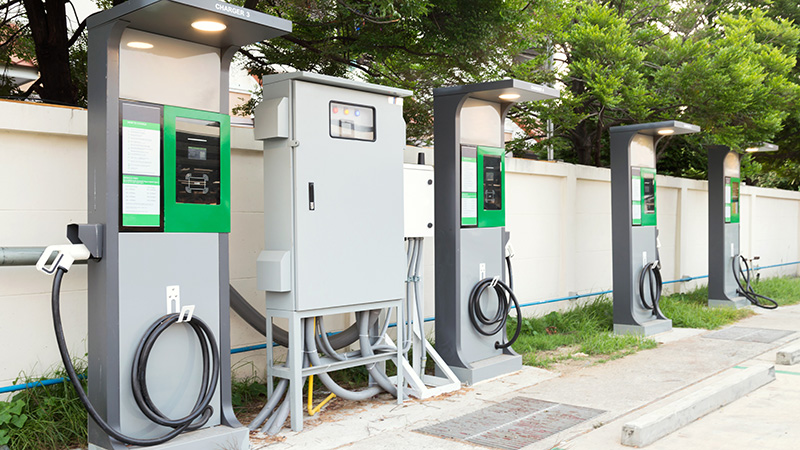August 22, 2022
States across the West joined other states, as well as the District of Columbia and Puerto Rico, in submitting National Electric Vehicle Infrastructure (NEVI) plans to the federal government in recent weeks. These initial NEVI plans outline each state’s overall vision, specific goals, and initial approach toward a national network of electric vehicle (EV) corridors.
The plans aim to soothe a primary worry of EV drivers and would-be EV drivers: running out of charge when on the road, especially in states that have not seen the level of EV adoption needed to develop robust charging networks. Building out EV infrastructure will help increase EV use, and when those vehicles are powered by clean electricity, they can help us make substantial progress in curbing carbon pollution to address climate change.
The NEVI Formula Program was created in the federal Infrastructure Investment and Jobs Act (IIJA) in 2021, allocating $5 billion in funding for states to install direct current fast charging to create a nationwide EV charging network on a designated network of Alternative Fuel Corridors. The NEVI program marks a historic first step in creating the necessary infrastructure for EVs to eventually replace fossil-fueled cars.
The benefits of a widespread transition to EVs are immense. Electric vehicles do not emit harmful air and climate pollutants, which often disproportionately affect low-income communities living near major transportation corridors. EVs also provide fuel cost savings to consumers, particularly in the current market with gasoline prices much higher than average.
What Do NEVI Plans Do, and Why Do They Matter?
The NEVI program is a significant step toward increasing the number of publicly available EV chargers that will help alleviate range anxiety and provide the backbone for all-electric interstate travel. Each state’s NEVI plan designates a range of alternative fuel corridors and steps for filling in charging gaps every 50 miles along these routes.
For some locations, no action is required, as charging infrastructure already exists. In other locations, existing charging stations will be upgraded to meet NEVI technical specifications, or new charging stations will be built. Each state in our region has adapted its plan to meet the state’s unique circumstances and needs.
Arizona
Arizona’s NEVI plan suggests that all sites should consider including distributed energy resources, such as solar arrays, and sites with electric grid resilience concerns should consider backup generation and energy storage. For sites in remote areas, this approach offers assurance that EV drivers will not lack charging even in extreme circumstances, inspiring greater confidence in the availability of EV charging on Arizona’s roads.
Colorado
Colorado’s plan has expanded the number of designated corridors to give EV drivers the ability to quickly recharge in even the most remote parts of the state. Colorado was the only state in the Interior West to significantly expand the number of designated EV corridors. To ensure NEVI funds can cover more corridors across the state, Colorado is proposing an exemption to the total number of charging ports required by NEVI in places with low initial utilization.
Colorado also intends to “future-proof” chargers across the state by requiring charging infrastructure to be built in a way that allows easy expansion as usage increases. States across the region should urge the federal government to approve this strategy for all NEVI charger installation. Ensuring stations are “future-proofed” would allow for rapid expansion of the EV charging network as EV adoption increases across the region.
Nevada and New Mexico
Nevada and New Mexico plan to complete the buildout of chargers along major interstate highways within the first and second years of their NEVI plans, respectively. Because Nevada and New Mexico have vast stretches of rural highways, the two states also want to have certain stretches of rural highways removed from NEVI designation. Their concern is that building EV chargers will require significant investments in electrical grid expansion to accommodate NEVI requirements. The ability to de-designate these routes would allow the states significantly more flexibility to use NEVI funding for chargers in rural communities that may not require charging infrastructure of the high standards required by the NEVI federal guidance.
While this strategy may be appropriate in some areas, states should endeavor to base corridor designations on quantifiable metrics, such as average annual daily traffic, to ensure the busiest roads can support EV drivers. Major population centers should also be connected by routes that have EV charging, to ensure an equitable distribution of benefits across the population. For example, in New Mexico’s NEVI plan, Farmington, the fourth-largest population center in New Mexico, is unconnected to other parts of the state via a designated corridor, despite having relatively high charger density in the city.
If the federal government does not institute a process for de-designating corridors, another strategy would be to seek exemptions to the overall NEVI standards for individual stations while “future-proofing” for later expansion.
Utah
Utah’s plan calls for all charging stations to share data with the Utah Department of Transportation, giving the department access to information that includes charging session length, time of day, peak power usage, and charger connector type. This information will help the department track how the NEVI chargers are used and their reliability, allowing the department to update its NEVI plan based on data.
How Will Upcoming Federal Funding Opportunities Help Accelerate Electric Vehicle Use Across the West?
The corridor chargers required by the NEVI program are only a small part of the overall charging infrastructure we need. The federal Infrastructure Investment and Jobs Act provides several pots of money that states can access to further build out EV chargers. Later this year, another $2.5 billion in grants will be made available for expanding EV charger deployment in communities and filling any additional gaps along the alternative fuel corridors. Several other programs were amended to make EV charger projects eligible investments for Federal Highway Aid funding.
States should endeavor to allocate a portion of funding from these amended programs (such as the Surface Transportation Block Grant Program and the National Highway Performance Program) in order to greatly expand the amount of federal funding they are receiving to expand access to EV charging.
What’s Next for Western States and Their NEVI Plans?
The federal government has until September 30, 2022, to approve the states’ plans or request any necessary changes. Once plans have been approved, states will receive funding and can begin their projects. Required annual updates to the NEVI plans will ensure states are adaptive to a rapidly shifting market of current and future EV drivers. After the federal alternative fuel corridors are fully built out, NEVI funds could be used to build charging infrastructure in communities beyond the corridors.
Charging availability in population centers not located on the network of federal Alternative Fuel Corridors will support widespread EV adoption, especially for EV drivers who do not live in homes with dedicated charging. States with large tourist attractions that are not on alternative fuel corridors also will seek to install charging, to enable EV drivers to visit with ease.
WRA will continue to engage on these charging infrastructure issues, advocating for a future when all Westerners can access the benefits of EVs.




